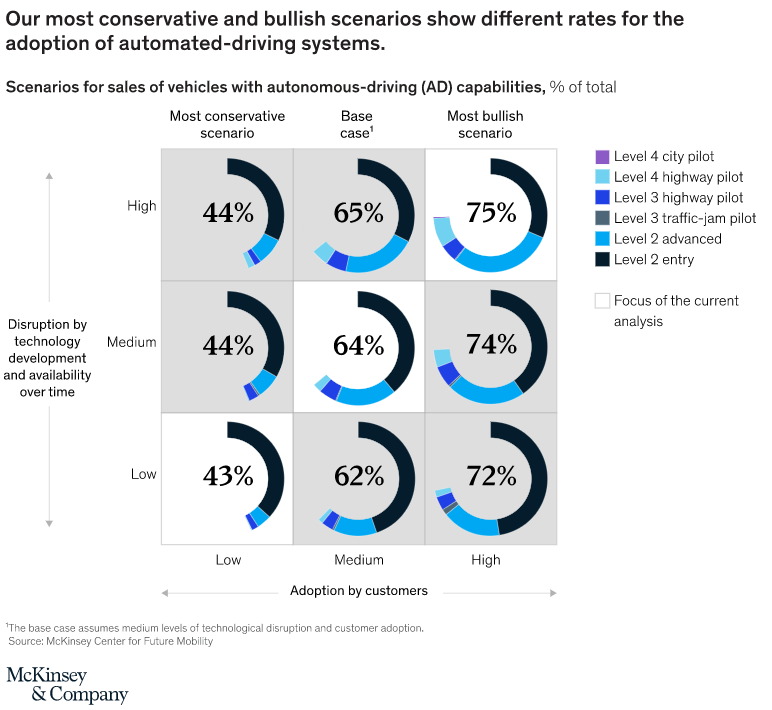The topic of autonomous cars is one that’s dominated tech news feeds for the past decade. While The Guardian predicted that we’d all be backseat drivers by 2020, we still appear to be no closer to owning our very own self-driving car. Safety concerns have often been a key discussion point when considering barriers to adoption, but the cost of this technology demands attention too.
The Guardian’s prediction is just one of a wide range of forecasts regarding the arrival of autonomous vehicles and when they’ll hit the roads. With estimated arrival dates ranging to just about any time over the 21st Century, you could essentially believe anything you want.

(Image: McKinsey)
In the chart above, we can see that even in the most bullish of scenarios, the vehicle sales of highly autonomous vehicles will still be overshadowed by non-autonomous vehicles or motors with entry-level autonomy – indicating that there will still be barriers to usage.
Away from the hype, one of the biggest causes of these wildly different predictions of when self-driving cars will actually arrive boils down to the definition of what autonomy really is when it comes to driving. Popularly, self-driving refers to a car that requires zero human input in getting from A to B. Many of the predictions surrounding these vehicles are based on any applicable use cases – many of which are so sparse that there’s too little to work with.
While there are plenty of predictions in circulation about when we’ll actually see the first self-driving cars hit the road, publications are altogether more reserved when it comes to counting the cost of such a significant technological shift.
Tesla’s Dynamic Pricing
The most tangible evidence we have of the costs associated with using an autonomous personal vehicle comes from the pricing structure of Tesla’s ‘full self-driving’ option on its motors.
Interestingly, the price of going autonomous in a Tesla will be dynamic based on the quality of technology available. The most recent revision for full self-driving technology by Tesla came in July 2020, when the price of the add-on was raised by $1,000 to $8,000.
Explaining Tesla’s pricing strategy, CEO Elon Musk said: “The FSD price will continue to rise as the software gets closer to full self-driving capability with regulatory approval – at that point, the value of FSD is probably somewhere in excess of $100,000.”
Of course, it’s worth noting that, in its current form, Tesla’s full self-driving technology is still a far cry from fully autonomous driving. However, the $8,000 price tag for the developing technology could be a cause for optimism among users looking to adopt autonomous vehicles in the future.
The Cost of Safer Transport
Road crashes claim around 1,750 lives each year in the United Kingdom. The result is significant financial and emotional suffering in society. The arrival of autonomous vehicles promises to help prevent more road deaths by shifting responsibility from humans to machines – minimising the incidences of human error leading to accidents.
However, the safety systems inside autonomous vehicles are the biggest cost factor when compared to more manual, less-safe vehicles. The various sensors, radar, and communication devices embedded in self-driving cars are intuitive and life-saving devices, but they’re key reasons why the technology will be so unaffordable.
Despite the steep costs associated with making the roads safer, Harvard Business Review anticipates that consumer subsidies will likely be put in place to help more drivers to realise the life-saving benefits of autonomous technology. Although this may be challenging to implement, in the US, public revenues already pay for a portion of road crash expenditures amounting to $18 billion – the equivalent of over $156 in added taxes for each household.
If consumer subsidies can convert these funds into the adoption of safer autonomous vehicles then it could be a mutually beneficial reallocation of funds.
Payment Hurdles
Some of the biggest issues regarding autonomous vehicle adoption revolve around other payments associated with driving. For instance, how does insurance work when your car is being driven from A to B without any significant human intervention? What road tax is applicable for a fully electric, autonomous road vehicle?
If the responsibility for accidents falls on the organisation that programmed the technology rather than the vehicle owner, it could significantly change the overall price of autonomous vehicle ownership.
With cloud computing, the technology inside autonomous vehicles could be capable of updating and becoming more advanced even after the initial purchase. This has the potential to fundamentally restructure how we pay for our cars, with finance schemes becoming more commonplace. Additionally, with the safety benefits that autonomous vehicles offer to roads, it’s even possible that car finance for bad credit buyers could also be more lenient in the future.
Autonomous cars may still be a few years – or a number of decades – away depending on which articles you read. But the safety benefits that a fully realised self-driving vehicle can bring may be the key to generating the subsidies needed to make the technology affordable.
